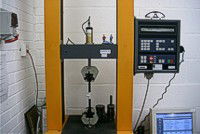IEC 61386 is the new European standard governing the performance of flexible conduit (and rigid) systems in electrical installations. Voltimum UK Managing Editor James Hunt introduces this new standard in brief:

Full implementation of IEC 61386 is being phased in throughout 2006, and it is expected that the standard will fully replace EN 50086 by 2007.
Those manufacturers of flexible conduit and trunking which can demonstrate full compliance with the new standard (for example, in the UK via BSI and the Kitemark scheme), especially if confirmed by independent third party certification, will be in a good competitive situation in terms of sales. This is because such manufacturers' customers will be able to confidently specify flexible conduit systems complying with IEC 61386 for the complete range of suitable applications, knowing that they have been approved to the new scheme. Such customers often face strict controls on their working environments, and may typically include food processing, healthcare, hazardous area, MOD and other specialist markets.
Tests to be carried out under IEC 61386:
The new IEC 61386 standard requires a number of tests to be carried out on specimen conduit materials. These include:
- Impact Strength Test
- Peak Load Test
- Reverse Bending Test (With Swinging Movements)
- Self-Extinguishing
- System Pull Out Strength.
The Impact Strength Test - This is carried out on conduits over a range of different temperatures. The test is made on each specimen using an impact head with a defined profile. Conventionally, fracture behaviour is studied, but under this test, it is the deformation (buckling) behaviour that is also determined. The specimen passes the test if no fracture occurs after impact, and there is also no excessive permanent deformation.
The Peak Load Test - Under the requirements of this test, carried out on conduit specimens under standard ambient conditions (which is specified as 23°C at 50% relative humidity), the conduit is deformed by a defined amount between two plates.
The Reverse Bending Test (With Swinging Movements) - This test is based on a cyclic reversed bending of conduits under various temperatures. Under the requirements for the test, conduits are dynamically loaded and evaluated over the temperature limits. The number of bending cycles taken to fracture the conduit determines its strength.
The Self-Extinguishing Test - Under the requirements for this test, the conduit is exposed to a flame (from a standard burner). The time to ignition (if any), the flame propagation, and the time to self-extinguishing after flame removal are all parameters measured.
The System Pull-Out Strength Test - This pull-out test covers conduits as well as attached associated connectors under 23°C / 50% relative humidity ambient conditions. The pull-out strength is determined by a tensile test.
For more information about specific tests, please go to the VoltiBULLETIN article entitled 'IEC 61386 - and what it means'.
Other parts of IEC 61386:
There are other aspects to the new IEC 61386, not all of which are related to flexible conduit. In total, IEC 61386 comprises the following parts under the general title Conduit Systems for Cable Management:
- Part 1: General requirements
- Part 21: Particular requirements - Rigid conduit systems
- Part 22: Particular requirements - Pliable conduit systems
- Part 23: Particular requirements - Flexible conduit systems
- Part 24: Particular requirements - Conduit systems buried underground.
Taking, for example, Part 24 of IEC 61386. This specifies the requirements for conduit systems buried underground, and is to be used in conjunction with IEC 61386-1, Conduit systems for cable management - Part 1: General Requirements (and amendments). Part 24 supplements or modifies the corresponding clauses of IEC 61386-1. A conduit system that complies with this standard is deemed safe for use when installed in accordance with national wiring regulations, whilst applying the manufacturers' installation instructions and conduit classification.
Voltimum UK Manufacturing Partners Kopex and Adaptaflex both manufacture conduit systems to the requirements of IEC 61386. Both companies now have the appropriate approvals, making them among the very first (possibly the first) manufacturers whose products fully comply with the new standard, as verified by independent third party certification.
For more information on all aspects of IEC 61386, please see the standard.